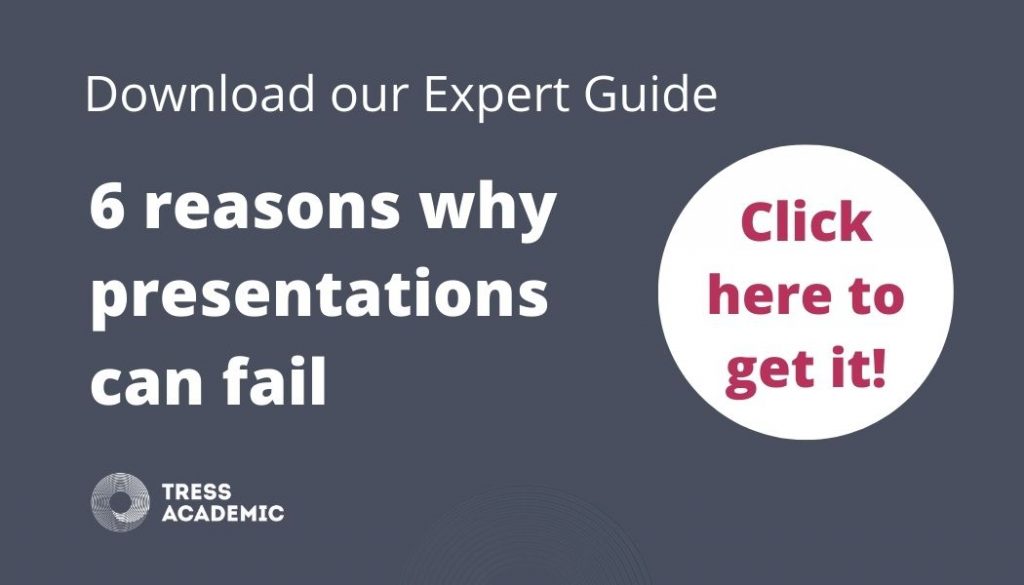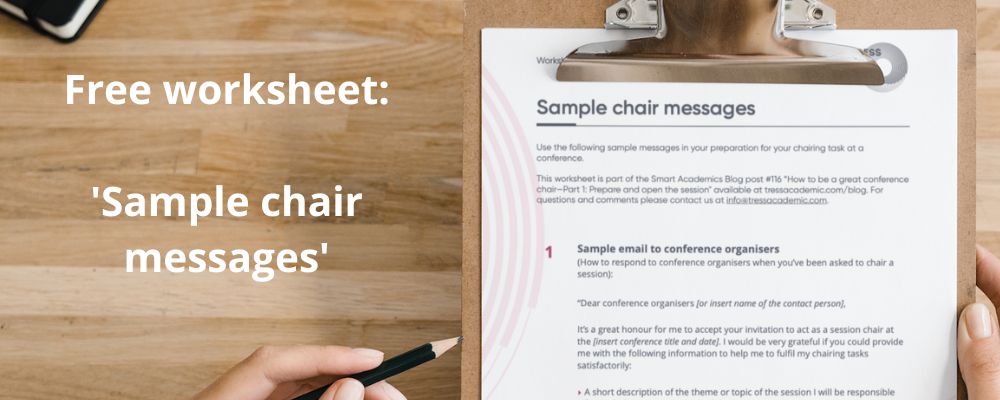Is chairing a conference session new to you? Have you always wondered what the responsibilities of a chairperson are? Have you been asked to chair a session at an in-person or a virtual conference and want to do it well? In our two-part post, you’ll get our comprehensive tips for being a great conference chair. Part 1 is about preparing beforehand and how to get the sessions started.
This post is part 1 of a two-part post on becoming a great session chair at a conference. Access part 2 here and read about how to manage time, presenters, and questions from the audience.
Why do we need good conference chairs?
If you have ever joined an academic conference either as an audience member or a presenter you most likely met the person chairing a session of several presentations—the chair. At first glance, chair persons may not seem to have an important role in the conference. They say “hello” at the beginning and “thank you” at the end of a talk. The presenters deliver the interesting stuff, not the chairs.
But have you ever experienced something like this: sitting in the audience, waiting for the session to start and the first presenter to come on stage, but nothing happened? Ten minutes past the scheduled starting time, the seats filled, and no one appeared on stage? After a while, the second presenter on the programme talked to a person—presumably the session chair—and five minutes later, the session finally started with presenter number two on stage, jumping in for an obviously absent presenter number one. The chair didn’t say a word to the audience.
Or, have you ever experienced this: You’ve been waiting for your presentation slot at a conference session but the presenter before you went on and on? What was supposed to be a 15-minute presentation by the speaker before you went on for 22 minutes with no end in sight, plus the question time after the talk had not even started. Anxiously you were staring at the session chair, sitting in the front row, enthralled by the presenter and seemingly unaware of the task of chairing the session. “Is there nobody who can stop this mess?” you whispered to yourself and looked at your watch. You feared that the overtime from the previous presenter would be taken off your presentation time.
Looking closer at both situations, what went wrong? A good and proactive chairperson was missing–someone to control the session and guide the presenters and the audience. What was needed was a chair knowledgeable in the responsibilities of this position making sure that the conference session and all presenters are not running into trouble. The chair needs to facilitate a session and, if problems come up, get the session back on track.
Many of us have had a similar experience, waiting for a chair to jump in and stop an endless presenter, or when the chair didn’t follow the schedule and the presenters had to manage themselves, or when you’ve been presenting and the chair was not prepared and got things about you wrong.
Thus, at a second glance, being a chair is an important task and contributes a lot to the success of a session and a conference. Being a chair is also an interesting way of participating in a conference. Suddenly, you experience another dimension of all those presentations being held at conferences. You’re not only a passive consumer of conference talks in the audience, but you have the chance to contribute to the success of the event.
Surprisingly, there is no training involved in being a good chair. It is an honour and a responsibility, but many people never get any detailed instructions on what they are supposed to do. Even conference organisers sometimes only provide loose instructions to their session chairs.

How to become a good session chair
There aren’t any tricks to being a great chair, but it requires just a little bit more preparation than knowing ‘where to be when!’ This is why we would like to assist you with our two-part post on being a great session chair. We present a total of 50 preparation steps and tips that you can apply when you are pushed into the situation of having to chair a conference session–virtually or in-person. Step-by-step, we’ll give you suggestions on what to do in which phase of the chairing process. And we offer two free worksheets to help you with your first or next chairing task.
In part 1, you’ll learn all the steps that you can take to prepare before the conference starts up until the opening of your session. In part 2, you’ll learn about the important dynamics to be aware of when chairing a session–it’s about how to manage time, the presenters, and the questions from the audience. Access part 2 of this post here.
Both parts of the post include worksheets. The first one, Sample chair messages, provides sample formulations that you can use to contact the conference organisers and the presenters before the conference, as well as sample texts for your session opening and for introducing the presenters. The second worksheet, My session chair prep list, includes a handy checklist to tick off all the steps you need to prepare and are easily applicable to most chairing situations.

Preparation before the conference
- When you accept an invitation to be a session chair at a conference, get in touch with the conference organisers and ask them to provide any instructions that you should follow. See the worksheet Sample chair messages for a sample email.
- Ask for a theme description of your session (if available) and the list of the presenters and their topics.
- Contact your speakers before the conference by email (or address them at the conference) and ask them for a short biography (see a sample email in the worksheet Sample chair messages for what information to collect). The information will help you introduce each speaker properly.
- Get to know your session and your speakers–learn their names, get their affiliations right, and their presentation titles.
- Tell the speakers what the slot length is for their talk and how much of it is reserved as time for questions, as well as if you will run questions after each talk or take them all together at the end.
Preparation before the session
- Agree with all presenters to meet 15 minutes before the session starts to get to know each other briefly and make sure everyone is there.
- Ask them how you should introduce them and—if applicable—how their names are pronounced.
- In the meeting, make sure everyone gets familiar with the presentation equipment and stage, and ensure that everyone has uploaded their presentations on the presentation device. This helps to reduce transition time between presenters later.
- Agree on the signs you will show them to inform them about their timing (see also part 2 of this post.
- Have a short conversation with each presenter to break the ice. They might be nervous—particularly if they are not experienced presenters—as it’s good for them to know you’re supporting them.
- Have a copy of the conference programme and the session schedule. Be aware of fixed time slots for coffee breaks and refreshments.
- Know where to find technical support if something breaks down in your session.
When you open the session
- Start your session on time, and don’t wait for late-comers—you don’t want those who showed up on time to wait.
- Create a friendly atmosphere by welcoming everyone.
- It’s good to have a well-prepared statement on-hand regarding the topic of the session and what the audience can expect. You can also announce changes in the programme or any housekeeping issues, and ask the audience to mute their phones. See a sample opening in the free worksheet Sample chair messages.
- Don’t waste the time of your audience and your presenters. The audience came to listen to the presenters, not you.
When the presentations start
- Introduce each speaker. Keep the length of your introduction short and appropriate to the length of each presentation slot. For a 15 minute presentation, you shouldn’t take 5 minutes–1 min is long enough, 30 seconds is even better.
- Typically you’ll provide the name, the institution, the project or position of the presenter, as well as the title of the talk. Start the introduction in a formal style, which means mentioning the full name and the title, even for people you know personally—the audience might not know them so well. From then on, you can refer to them by first name. See a sample introduction in the worksheet Sample chair messages.
- Some presentations have a long and complicated title, so it might be a good idea to paraphrase them in your introduction.
- Once you’ve made the introduction, you need to disappear. The attention of the audience should be completely on the speaker, but make sure that presenters can see you during their talk—establish eye-contact.
- Give every presenter the same attention, highlight their contributions and, if applicable, their publications equally.
- Smile at the presenters, look at them, show them that you’re following them closely and that you’re interested in their talk. Nodding your head signals agreement and helps to calm down the nerves of the presenter. Be a role model for the audience.
- Take notes on every talk. Eventually, you may need your notes to ask questions yourself or for a session summary.
- Start applauding the presenters right when the talk is over so the audience knows it’s time for clapping. Encourage young and less-experienced presenters, and thank them for their valuable presentations.
Conclusion
You see, there are many steps that can easily be taken before and at the conference session to help you be a great session chair. Now check out the second part of this post to find out how to master the challenge of managing time, presenters, and questions from the audience as a session chair, including a great downloadable checklist.

Access “How to be a great conference chair—Part 2: Managing time, presenters and questions
Resources:
- Worksheet: Sample chair messages
- Smart Academics Blog post # #26: First conference presentation? 17 life-saving tips
- Smart Academics Blog post #30:Questions from the audience you should be prepared to answer
- Smart Academics Blog post #95:Apply these 5 tips to improve any presentation
Relevant courses and services:
- 1-day course: Presenting successfully at virtual conferences
- 3-day course: How to present at international conferences
- 1-to-1 advice: Presentation Check
More information
Do you want to present successfully at conferences?
If so, please sign up to receive our free guides.
Photo by Virender Singh on Unsplash.
© 2022 Tress Academic
